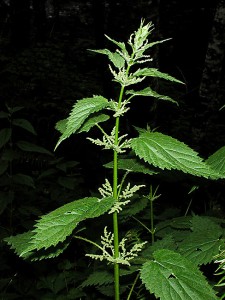Origin: Bulgaria
Other Names: nettle, stinging nettle, dog nettle, California nettle, dwarf nettle
Description: A common perennial with a square bristly stem 2-3 feet high, with opposite cordate petiolate deeply serrated pointed leaves which are downy underneath. Covered in rigid stinging hairs which contain an irritating fluid. Small greenish flowers in axillary clusters bloom in summer. Nettle root consists of the dried or fresh roots of Urtica dioica or Urtica urens. However, in many instances in herbals, nettle root is not referred to or recommended separately from the whole plant. Most often, herbals refer to nettle as the whole plant, and describe its uses accordingly. Germany”s Commission E and ESCOP recommend nettle root specifically for relieving urinary disorders associated with BPH, benign prostatic hyperplasia. The British herbal Compendium recommends nettle leaf or herb as a mild diuretic and as a hemostatic (to check blood flow). But nettle”s uses are far broader. Dr. James Duke cites a multitude of therapeutic uses for nettle, which are listed here. In only a few instances does Dr. Duke specify leaf or herb versus whole plant. Those uses are noted here. He recommends use of nettle for allergies (leaf), Alzheimer”s disease, arthritis (leaves), asthma, baldness (leaves), bladder infections, bronchitis, bursitis, cough (leaves), gingivitis, gout, hives, kidney stones, laryngitis, multiple sclerosis, PMS, enlarged prostate (roots), sciatica, and tendonitis.
Medicinal History: Nettle root or whole plant has been used in traditional folk medicine as an astringent, a diuretic, and a tonic herb. Internally nettle has been employed to treat anemia, uterine hemorrhage, excessive menstruation, hemorrhoids, arthritis, rheumatism, gout and skin eruptions. Topically, preparations of nettle have been employed to relieve arthritic pain, gout, sciatica, neuralgia, hemorrhoids, scalp and hair problems, burns and insect bites and stings.
Nettle was used during the time of Hippocrates to treat bites and stings, and European herbalists employed nettle tea for respiratory disorders. Native Americans employed nettle for a plethora of purposes, including as a snuff for nosebleeds, an analgesic and anti-rheumatic, as an herbal steam to relieve pain, as a whip to relieve rheumatic pain, as an infusion to aid delivery, as a poultice applied to aching joints, as a decoction or infusion for various bladder and urinary disorders, as an inhalant for for grippe or pneumonia, as an infusion for fevers, as a general tonic, a hair wash, and to relieve skin inflammations.
Habitat & Cultivation: Nettle is found widely throughout North America and Europe, where it grows abundantly as a weed. The leaves and stems are covered with stinging hairs, thus the name stinging nettle. The plant grows commonly in ditches, thickets, fields and pastures. Typically the whole plant is harvested, as the root is therapeutically valuable. Nettle is typically dried prior to preparation as a medicine, but fresh nettle is also be juiced or extracted for therapeutic purposes.
Though nettle”s therapeutic activities aren”t completely understood, the plant contains a variety of antioxidant compounds which protect cells and enhance tissue health. The plant contains a number of anti-inflammatory compounds, which may account for its multiple uses for treating inflammation. The plant is also rich in minerals of value to skin and hair, which may explain its beneficial uses for both. Nettle also contains diuretic agents and phytochemicals which help to control bleeding.
Contemporary Uses Approved by Authoritative Bodies:
Germany”s Commission E and ESCOP approve the use of nettle root:
For symptomatic treatment of urinary disorders in cases of Benign Prostatic Hyperplasia, BPH. Nettle root helps to promote healthy urinary flow.
Allergy precautions: Some people may be allergic to nettle.
Usage Tips: Steep 1.5 grams of nettle root in 150 ml (5 ounces) of boiled water for 10 ” 20 minutes. Strain and drink, 3-4 times daily.
If you are using nettle root extracts or other supplement products, follow usage instructions on the labels.
Science Update: The use of nettle root for treating urinary symptoms of benign prostatic hyperplasia is positive.
Nettle root contains a number of beneficial phytochemicals which appear to influence the function of the prostate, interact with sex hormones, slow the growth of prostate cells, fight prostate cancer, and reduce inflammation.
From our catalog you can order Stinging Nettles – leaves ( Folia Urticae ) and root ( Radix Urticae ).

 Български
Български
Leave a Reply